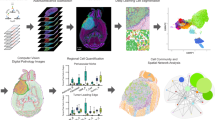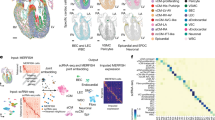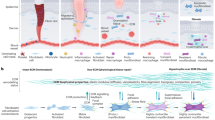Abstract
During wound repair, branching morphogenesis and carcinoma dissemination, cellular rearrangements are fostered by a solid-to-liquid transition, known as unjamming. The biomolecular machinery behind unjamming and its pathophysiological relevance remain, however, unclear. Here, we study unjamming in a variety of normal and tumorigenic epithelial two-dimensional (2D) and 3D collectives. Biologically, the increased level of the small GTPase RAB5A sparks unjamming by promoting non-clathrin-dependent internalization of epidermal growth factor receptor that leads to hyperactivation of the kinase ERK1/2 and phosphorylation of the actin nucleator WAVE2. This cascade triggers collective motility effects with striking biophysical consequences. Specifically, unjamming in tumour spheroids is accompanied by persistent and coordinated rotations that progressively remodel the extracellular matrix, while simultaneously fluidizing cells at the periphery. This concurrent action results in collective invasion, supporting the concept that the endo-ERK1/2 pathway is a physicochemical switch to initiate collective invasion and dissemination of otherwise jammed carcinoma.
This is a preview of subscription content, access via your institution
Access options
Access Nature and 54 other Nature Portfolio journals
Get Nature+, our best-value online-access subscription
$29.99 / 30 days
cancel any time
Subscribe to this journal
Receive 12 print issues and online access
$259.00 per year
only $21.58 per issue
Buy this article
- Purchase on Springer Link
- Instant access to full article PDF
Prices may be subject to local taxes which are calculated during checkout






Similar content being viewed by others
Data availability
The authors declare that all data supporting the findings of this study are available within the paper and its supplementary Information files and from the corresponding authors upon reasonable request.
Code availability
The codes used for the analysis are all indicated in the Methods.
Change history
27 September 2022
A Correction to this paper has been published: https://doi.org/10.1038/s41563-022-01365-4
References
Hakim, V. & Silberzan, P. Collective cell migration: a physics perspective. Rep. Prog. Phys. 80, 076601 (2017).
Haeger, A., Wolf, K., Zegers, M. M. & Friedl, P. Collective cell migration: guidance principles and hierarchies. Trends Cell Biol. 25, 556–566 (2015).
Park, J. A., Atia, L., Mitchel, J. A., Fredberg, J. J. & Butler, J. P. Collective migration and cell jamming in asthma, cancer and development. J. Cell Sci. 129, 3375–3383 (2016).
Bi, D., Yang, X., Marchetti, M. C. & Manning, M. L. Motility-driven glass and jamming transitions in biological tissues. Phys. Rev. X 6, 021011 (2016).
Sadati, M., Taheri Qazvini, N., Krishnan, R., Park, C. Y. & Fredberg, J. J. Collective migration and cell jamming. Differentiation 86, 121–125 (2013).
Atia, L. et al. Geometric constraints during epithelial jamming. Nat. Phys. 14, 613–620 (2018).
Garcia, S. et al. Physics of active jamming during collective cellular motion in a monolayer. Proc. Natl Acad. Sci. USA 112, 15314–15319 (2015).
Oswald, L., Grosser, S., Smith, D. M. & Kas, J. A. Jamming transitions in cancer. J. Phys. D 50, 483001 (2017).
Haeger, A., Krause, M., Wolf, K. & Friedl, P. Cell jamming: collective invasion of mesenchymal tumor cells imposed by tissue confinement. Biochim. Biophys. Acta 1840, 2386–2395 (2014).
Sigismund, S. & Scita, G. The ‘endocytic matrix reloaded’ and its impact on the plasticity of migratory strategies. Curr. Opin. Cell Biol. 54, 9–17 (2018).
Corallino, S., Malabarba, M. G., Zobel, M., Di Fiore, P. P. & Scita, G. Epithelial-to-mesenchymal plasticity harnesses endocytic circuitries. Front. Oncol. 5, 45 (2015).
Palamidessi, A. et al. Endocytic trafficking of Rac is required for the spatial restriction of signaling in cell migration. Cell 134, 135–147 (2008).
Frittoli, E. et al. A RAB5/RAB4 recycling circuitry induces a proteolytic invasive program and promotes tumor dissemination. J. Cell Biol. 206, 307–328 (2014).
Malinverno, C. et al. Endocytic reawakening of motility in jammed epithelia. Nat. Mater. 16, 587–596 (2017).
Giavazzi, F. et al. Giant fluctuations and structural effects in a flocking epithelium. J. Phys. D 50, 384003 (2017).
Giavazzi, F. et al. Flocking transitions in confluent tissues. Soft Matter 14, 3471–3477 (2018).
Mendoza, M. C. Phosphoregulation of the WAVE regulatory complex and signal integration. Semin. Cell Dev. Biol. 24, 272–279 (2013).
Debnath, J., Muthuswamy, S. K. & Brugge, J. S. Morphogenesis and oncogenesis of MCF-10A mammary epithelial acini grown in three-dimensional basement membrane cultures. Methods 30, 256–268 (2003).
Levitzki, A. & Gazit, A. Tyrosine kinase inhibition: an approach to drug development. Science 267, 1782–1788 (1995).
Lang, E. et al. Coordinated collective migration and asymmetric cell division in confluent human keratinocytes without wounding. Nat. Commun. 9, 3665 (2018).
Zeigerer, A. et al. Rab5 is necessary for the biogenesis of the endolysosomal system in vivo. Nature 485, 465–470 (2012).
Kirchhausen, T., Owen, D. & Harrison, S. C. Molecular structure, function, and dynamics of clathrin-mediated membrane traffic. Cold Spring Harbor Perspect. Biol. 6, a016725 (2014).
Sigismund, S. et al. Clathrin-mediated internalization is essential for sustained EGFR signaling but dispensable for degradation. Dev. Cell 15, 209–219 (2008).
Johannes, L., Parton, R. G., Bassereau, P. & Mayor, S. Building endocytic pits without clathrin. Nat. Rev. Mol. Cell. Biol. 16, 311–321 (2015).
Caldieri, G. et al. Reticulon 3-dependent ER-PM contact sites control EGFR nonclathrin endocytosis. Science 356, 617–624 (2017).
Koivusalo, M. et al. Amiloride inhibits macropinocytosis by lowering submembranous pH and preventing Rac1 and Cdc42 signaling. J. Cell Biol. 188, 547–563 (2010).
Di Guglielmo, G. M., Baass, P. C., Ou, W. J., Posner, B. I. & Bergeron, J. J. Compartmentalization of SHC, GRB2 and mSOS, and hyperphosphorylation of Raf-1 by EGF but not insulin in liver parenchyma. EMBO J. 13, 4269–4277 (1994).
Vieira, A. V., Lamaze, C. & Schmid, S. L. Control of EGF receptor signaling by clathrin-mediated endocytosis. Science 274, 2086–2089 (1996).
McDonald, P. H. et al. Beta-arrestin 2: a receptor-regulated MAPK scaffold for the activation of JNK3. Science 290, 1574–1577 (2000).
Villaseñor, R., Nonaka, H., Del Conte-Zerial, P., Kalaidzidis, Y. & Zerial, M. Regulation of EGFR signal transduction by analogue-to-digital conversion in endosomes. eLife 4, e06156 (2015).
Barrett, S. D. et al. The discovery of the benzhydroxamate MEK inhibitors CI-1040 and PD 0325901. Bioorg. Med. Chem. Lett. 18, 6501–6504 (2008).
Kirchhausen, T., Macia, E. & Pelish, H. E. Use of dynasore, the small molecule inhibitor of dynamin, in the regulation of endocytosis. Methods Enzymol. 438, 77–93 (2008).
Komatsu, N. et al. Development of an optimized backbone of FRET biosensors for kinases and GTPases. Mol. Biol. Cell 22, 4647–4656 (2011).
Itoh, F. et al. The FYVE domain in Smad anchor for receptor activation (SARA) is sufficient for localization of SARA in early endosomes and regulates TGF-β/Smad signalling. Genes Cells 7, 321–331 (2002).
Farooqui, R. & Fenteany, G. Multiple rows of cells behind an epithelial wound edge extend cryptic lamellipodia to collectively drive cell-sheet movement. J. Cell Sci. 118, 51–63 (2005).
Alekhina, O., Burstein, E. & Billadeau, D. D. Cellular functions of WASP family proteins at a glance. J. Cell Sci. 130, 2235–2241 (2017).
Mendoza, M. C. et al. ERK-MAPK drives lamellipodia protrusion by activating the WAVE2 regulatory complex. Mol. Cell 41, 661–671 (2011).
Innocenti, M. et al. Abi1 is essential for the formation and activation of a WAVE2 signalling complex. Nat. Cell Biol. 6, 319–327 (2004).
Steffen, A. et al. Sra-1 and Nap1 link Rac to actin assembly driving lamellipodia formation. EMBO J. 23, 749–759 (2004).
Ewald, A. J., Brenot, A., Duong, M., Chan, B. S. & Werb, Z. Collective epithelial migration and cell rearrangements drive mammary branching morphogenesis. Dev. Cell 14, 570–581 (2008).
Kim, H. Y. & Nelson, C. M. Extracellular matrix and cytoskeletal dynamics during branching morphogenesis. Organogenesis 8, 56–64 (2012).
Carey, S. P., Martin, K. E. & Reinhart-King, C. A. Three-dimensional collagen matrix induces a mechanosensitive invasive epithelial phenotype. Sci. Rep. 7, 42088 (2017).
Nguyen-Ngoc, K. V. et al. ECM microenvironment regulates collective migration and local dissemination in normal and malignant mammary epithelium. Proc. Natl Acad. Sci. USA 109, E2595–E2604 (2012).
Miller, F. R., Santner, S. J., Tait, L. & Dawson, P. J. MCF10DCIS.com xenograft model of human comedo ductal carcinoma in situ. J. Natl Cancer Inst. 92, 1185–1186 (2000).
Dvorak, H. F. Tumors: wounds that do not heal. Similarities between tumor stroma generation and wound healing. N. Engl. J. Med. 315, 1650–1659 (1986).
Vader, D., Kabla, A., Weitz, D. & Mahadevan, L. Strain-induced alignment in collagen gels. PLoS ONE 4, e5902 (2009).
Storm, C., Pastore, J. J., MacKintosh, F. C., Lubensky, T. C. & Janmey, P. A. Nonlinear elasticity in biological gels. Nature 435, 191–194 (2005).
Munster, S. et al. Strain history dependence of the nonlinear stress response of fibrin and collagen networks. Proc. Natl Acad. Sci. USA 110, 12197–12202 (2013).
Staneva, R., Barbazan, J., Simon, A., Vignjevic, D. M. & Krndija, D. Cell migration in tissues: explant culture and live imaging. Methods Mol. Biol. 1749, 163–173 (2018).
Yang, P. S. et al. Rab5A is associated with axillary lymph node metastasis in breast cancer patients. Cancer Sci. 102, 2172–2178 (2011).
Das, T. et al. A molecular mechanotransduction pathway regulates collective migration of epithelial cells. Nat. Cell Biol. 17, 276–287 (2015).
Mongera, A. et al. A fluid-to-solid jamming transition underlies vertebrate body axis elongation. Nature 561, 401–405 (2018).
Dang, T. T., Esparza, M. A., Maine, E. A., Westcott, J. M. & Pearson, G. W. ΔNp63α promotes breast cancer cell motility through the selective activation of components of the epithelial-to-mesenchymal transition program. Cancer Res. 75, 3925–3935 (2015).
Innocenti, M. et al. Abi1 regulates the activity of N-WASP and WAVE in distinct actin-based processes. Nat. Cell Biol. 7, 969–976 (2005).
Stradal, T. E. et al. Regulation of actin dynamics by WASP and WAVE family proteins. Trends Cell Biol. 14, 303–311 (2004).
Barry, D. J., Durkin, C. H., Abella, J. V. & Way, M. Open source software for quantification of cell migration, protrusions, and fluorescence intensities. J. Cell Biol. 209, 163–180 (2015).
Kardash, E., Bandemer, J. & Raz, E. Imaging protein activity in live embryos using fluorescence resonance energy transfer biosensors. Nat. Protoc. 6, 1835–1846 (2011).
Yang, Y. L., Leone, L. M. & Kaufman, L. J. Elastic moduli of collagen gels can be predicted from two-dimensional confocal microscopy. Biophys. J. 97, 2051–2060 (2009).
Beznoussenko, G. V., Ragnini-Wilson, A., Wilson, C. & Mironov, A. A. Three-dimensional and immune electron microscopic analysis of the secretory pathway in Saccharomyces cerevisiae. Histochem. Cell Biol. 146, 515–527 (2016).
Beznoussenko, G. V. & Mironov, A. A. Correlative video-light-electron microscopy of mobile organelles. Methods Mol. Biol. 1270, 321–346 (2015).
Park, J. A. et al. Unjamming and cell shape in the asthmatic airway epithelium. Nat. Mater. 14, 1040–1048 (2015).
Pastore, R., Pesce, G. & Caggioni, M. Differential variance analysis: a direct method to quantify and visualize dynamic heterogeneities. Sci. Rep. 7, 43496 (2017).
Barron, J. L., Fleet, D. J. & Beauchemin, S. S. Performance of optical flow techniques. Int. J. Comput. Vis. 12, 43–77 (1994).
Kubo, R. The fluctuation-dissipation theorem. Rep. Prog. Phys. 29, 255–284 (1966).
Castro, A. P. et al. Combined numerical and experimental biomechanical characterization of soft collagen hydrogel substrate. J. Mater. Sci. Mater. Med. 27, 79 (2016).
Acknowledgements
This work has been supported by: the Associazione Italiana per la Ricerca sul Cancro (AIRC) to G.S. (IG#18621), P.P.D.F (IG#18988 and MCO 10.000), and F.G. (MFAG#22083); the Italian Ministry of University and Scientific Research (MIUR) to P.P.D.F. and G.S. (PRIN: PROGETTI DI RICERCA DI RILEVANTE INTERESSE NAZIONALE – Bando 2017#2017HWTP2K); the Italian Ministry of Health (RF-2013-02358446) to G.S. Regione Lombardia and CARIPLO foundation (Project 2016-0998) to R.C.; Worldwide Cancer Research (WCR#16-1245) to S.S. C.M. and F.G. are partially supported by fellowships from the University of Milan, E.B. from the FIRC-AIRC. We thank J. Christian (Max Planck Institute for Medical Research, Heidelberg, Germany) for help with fluorescent beads.
Author information
Authors and Affiliations
Contributions
A.P., C.M. and E.F. designed and performed all the experiments and edited the manuscript. S.C. aided in generating cell lines and in the analysis of immunofluorescence and kinematic studies. E.B., S.S. and P.P.F.D. conceived the internalization assays and interpreted the trafficking results. G.V.B. performed EM studies. E.M., M.G. and D.P. aided in all the imaging acquisition, FRET and PIV analysis. C.T aided in the analysis of RAB5A expression in breast cancer. Q.L. and F.A. performed and analysed the AFM measurements. F.G. and R.C. analysed all the kinematic data, developed the tools for 3D motility and mechanical analysis, edited the manuscript and conceived part of the study together with C.M. E.A.C.-A helped in setting up the fluorescent bead assay. G.S. conceived the whole study, wrote the manuscript and supervised all the work. C.M., F.G., R.C. and G.S. are all equally responsible for this work.
Corresponding authors
Ethics declarations
Competing interests
The authors declare no competing interests.
Additional information
Publisher’s note: Springer Nature remains neutral with regard to jurisdictional claims in published maps and institutional affiliations.
Supplementary information
Supplementary Information
Supplementary Figs. 1–12, Supplementary Tables 1–4, Supplementary Video Legends 1–29, Supplementary Discussion and Supplementary references 1–19
Supplementary Video 1
RAB5A reawakening of collective motion in jammed epithelial monolayers depends on EGF
Supplementary Video 2
RAB5A reawakening of collective motion in jammed epithelial monolayers depends on EGFR
Supplementary Video 3
EGF-dependence of RAB5A flocking motility in EGFP-H2B-jammed epithelia monolayers
Supplementary Video 4
PIV analysis of EGF and EGFR-dependent endocytic unjamming
Supplementary Video5
RAB5A flocking motion in jammed epithelia is reduced by silencing Dynamin 2
Supplementary Video 6
RAB5A flocking motion in jammed epithelia is reduced by silencing RTN3, but not RTN4
Supplementary Video 7
RAB5A, but neither RAB5B nor RAB5C induces flocking motion in jammed epithelia
Supplementary Video 8
Flocking motion is abrogated by treatment with inhibitors of the MAPK/ERK1/2 pathway
Supplementary Video 9
Flocking motion is abrogated by treatment with Dynasore
Supplementary Video 10
MEK-DD is not sufficient to reawaken collective motion in jammed MCF10A monolayers
Supplementary Video 11
RAB5A-induced cryptic lamellipodia is compromised by treatment with MEK1/2 inhibitor
Supplementary Video 12
RAB5A-induced cryptic lamellipodia are inhibited by silencing the WAVE complex
Supplementary Video 13
RAB5A reawakening of collective motion in jammed epithelia is impaired by silencing NAP1
Supplementary Video 14
Silencing of NAP1 or WAVE2 affects RAB5A-induced wound closure in epithelial monolayers
Supplementary Video 15
Acini kinematic motility assay
Supplementary Video 16
PIV analysis on acini motility
Supplementary Video 17
RAB5A-mediated unjamming in MCF10A acini is trafficking-, EGFR- and ERK1/2-dependent
Supplementary Video 18
RAB5A-induced angular motion of MCF10A is independent of cell proliferation
Supplementary Video 19
RAB5A overcomes kinetic arrest of differentiated MCF10A acini
Supplementary Video 20
RAB5A reawakens collective motion in jammed MCF10.DCIS.com carcinoma cells
Supplementary Video 21
RAB5A promotes wound closure and flocking motion
Supplementary Video 22
RAB5A-mediated unjamming induces coordinated angular rotation in breast cancer spheroids
Supplementary Video 23
3D DVA of a RAB5A rotating spheroid after removal of the global rotation
Supplementary Video 24
RAB5A-flocking in spheroids is trafficking-, EGFR-, ERK1/2- and ARP2/3-dependent
Supplementary Video 25
RAB5A-mediated 3D unjamming promotes collective invasion in tumour spheroids
Supplementary Video 26
RAB5A spheroids exert larger stresses on surrounding ECM
Supplementary Video 27
Instantaneous velocity and stress maps of control and RAB5A-expressing spheroids.
Supplementary Video 28
RAB5A-mediated flocking promotes collective invasion in ex vivo DCIS tumour slices
Supplementary Video 29
PIV analysis on ex vivo DCIS tumour slice motility
Rights and permissions
About this article
Cite this article
Palamidessi, A., Malinverno, C., Frittoli, E. et al. Unjamming overcomes kinetic and proliferation arrest in terminally differentiated cells and promotes collective motility of carcinoma. Nat. Mater. 18, 1252–1263 (2019). https://doi.org/10.1038/s41563-019-0425-1
Received:
Accepted:
Published:
Issue Date:
DOI: https://doi.org/10.1038/s41563-019-0425-1
This article is cited by
-
Adherens junctions as molecular regulators of emergent tissue mechanics
Nature Reviews Molecular Cell Biology (2024)
-
Differences and similarities in biophysical and biological characteristics between U87 MG glioblastoma and astrocyte cells
Histochemistry and Cell Biology (2024)
-
Matrix viscoelasticity controls spatiotemporal tissue organization
Nature Materials (2023)
-
Curvature induces active velocity waves in rotating spherical tissues
Nature Communications (2023)
-
Tissue fluidification promotes a cGAS–STING cytosolic DNA response in invasive breast cancer
Nature Materials (2023)



